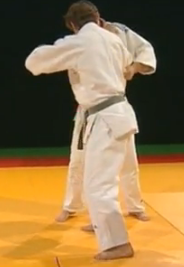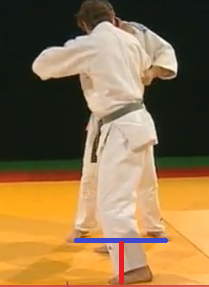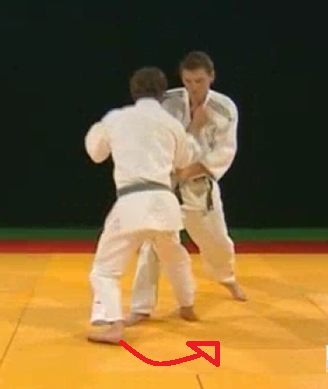This is an updated, revised and expanded version of a previous article – Practising Combinations. If you wish to still view the original un-revised article it will remain on the blog, but is now superseded by this article.
One of the biggest issues beginners have is practicing combinations whilst moving and especially so when the movement isn’t linear and is a free moving situation.
There are of course a number of reasons behind this, lack of control, poor spacing, simply not being good at the individual throws etc...
However, a major factor is a lack of awareness of how to properly position yourself relative to your partner in order to throw them.
T-ing Up
I was taught the concept of positioning for nagewaza as ‘t-ing up’, I have heard Neil Adams refer to it as ‘setting your line up’ your coach or club may have a different name for it. Regardless of what you call it the principle is universal and fundamental.
If you’re T-ed up you’re standing with your lead foot advanced at the peak of the triangle, you other foot roughly shoulders width behind it and your partner standing with both feet level.
Imagine that there is an invisible line running between uke’s toes and that it is bisected by another invisible line that runs between tori’s feet. These lines bisect each other in such a way that the line between uke’s feet forms the horizontal cross bar of a T shape and that the line between tori’s feet forms the vertical upright bar of the T.
This position should be familiar to most people because it is roughly how you’re positioned after you’ve taken your first step when practicing uchikomi or nagekomi.
From this position you’re ideally placed to turn in for a throw and your opponent is ideally positioned to be thrown.
Note that the foot positioning is not set in stone and the trailing foot doesn’t have to be precisely behind the advanced foot.
The vertical line of the T is only a rough guide for foot placement and having the trailing foot ‘off centre’ of the T is not wrong.
Drilling positioning
In a static situation with a compliant partner its incredibly easy to get into the T-ed up position and then perform a throw.
However, beginners often struggle to T-up when moving around in a non linear fashion for uchikomi and nagekomi.
As such its usually necessary to drill moving around with a partner and positioning yourself to perform a throw.
Here in a free movement drill tori and uke moves around with tori leading the movement, getting into the T-ed up position and then performing tsurikomi.
Very few beginners, however, after being shown and having the T-ing up concept explained are able to go straight away into a free moving drill and control the movement so that the T-up properly.
So the drill needs to be introduced progressively. The most basic form of drilling for positioning is circling.
In which tori will start the movement by stepping out with his non-lead foot, for a right hander this will be his left, for a left hander his right, bringing uke around with him.
Here a simple circling drill is used to position tori and uke so that tori is T-ed up, lead foot at the peak of the triangle and therefore perfectly positioned to apply his throw.
This is relatively straightforward and most beginners are able to circle and T-up after a short amount of practice.
However, when attempting to apply the T-ing up concept to live uchikomi or nagekomi combination practice most beginners often struggle because its not a simple circling type action, unless the initial technique is a Hiza guruma or Sasae tsurikomi ashi.
Often beginners will find that after applying a technique like O uchi gari they’re left in this position.
Not T-ed up and impossibly placed to attempt any follow up technique except an O soto gari or Sasae tsurikomi ashi.
In this situation all that is necessary to T-up and be correctly positioned is a simple backswing with the trailing foot.
When a Ko uchi gari is the initial attack simply perform a ‘frontswing’ with the trailing foot to bring yourself into position.
Sometimes during free moving uchikomi or nagekomi you will need to create space as part of your tai sabaki to ensure you’re correctly positioned and T-ed up.
To do this a simple method is what I call ‘pulsing’ where you use the tsugi ashi foot movement to ‘pulse’ your partner away to create space.
Just for forward throws?
Although most of the examples so far have been of the T-ing up positioning concept being used for forward throws it also applies to backwards throws as well.
The T-ing up concept being used to position for O uchi gari
The T-ing up concept being used to position for O uchi gari following an O soto gari attack
T-ing up for combinations
The real usefulness of the T-ing up concept is in helping people position themselves properly for practicing combinations.
Here for a Ko soto gari to Tai otoshi combination
O soto gari to O uchi gari
O uchi gari to Tai otoshi in kenka yotsu
Should I do this in randori?
Often when introduced to the T-ing up concept beginners will move around and try and get in precisely that position with the feet in complete alignment and attempt throws. This will almost always fail as the position’s purpose is to teach a concept not a cast iron rule.
Also beginners often try walking around T-ed up, again this is a mistake as its a position that’s basically impossible to get into or maintain against skilled opposition without being thrown and again the position is conceptual not mandatory.
That being said the concept can often be seen being applied in contests and randori. Here in a ‘grip to throw’ sequence Jeon of Korea brings his opponent into the T-ed up position through use of movement and scores Ippon.









Interesting. Something worth a try for me, someone who's at that awkward 2-yr frustration mark. Appreciate how much work went into this.
ReplyDeleteThe pictures links are broken : "Please update your account to enable 3rd party hosting"
ReplyDelete